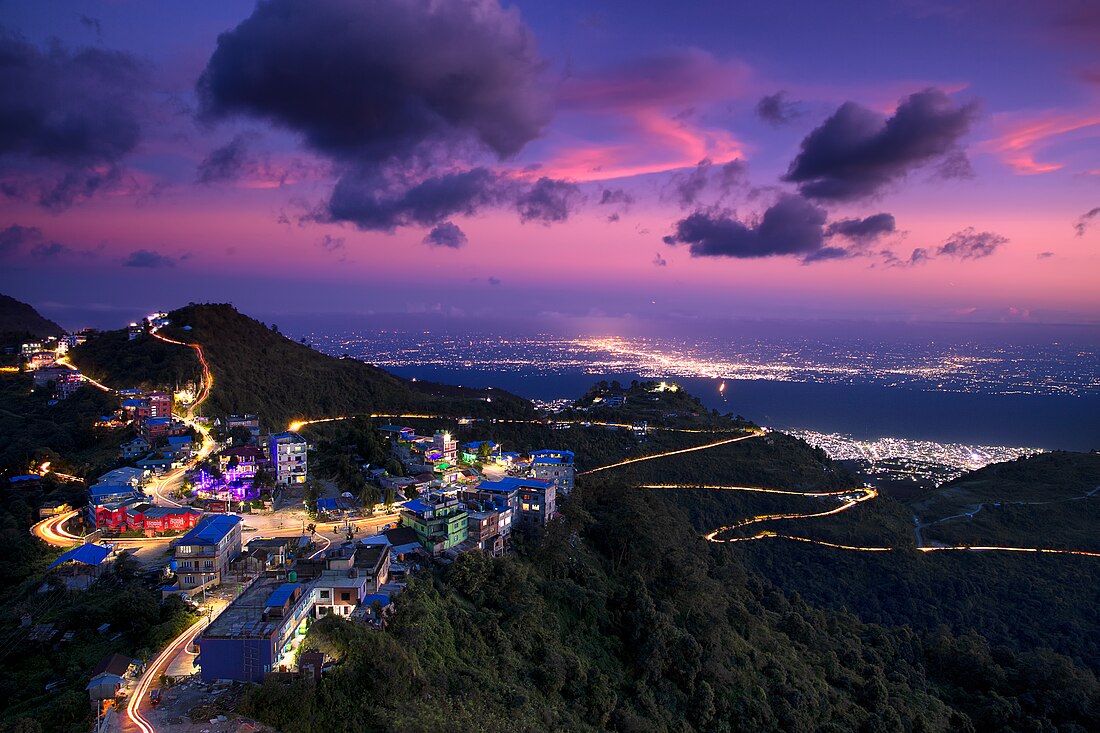Sunsari District
District in Koshi province From Wikipedia, the free encyclopedia
Sunsari District is one of 14 districts in Koshi province of eastern Nepal. The district is located in the eastern part of the Outer Terai and covers an area of 1,257 km2 (485 sq mi). According to the 2011 Nepal census, the population was 753,328.[1] The district headquarters is located in Inaruwa.
Sunsari District
Nepali: सुनसरी जिल्ला | |
|---|---|
 Location of Sunsari District in Province | |
| Country | Nepal |
| Province | Koshi Pradesh |
| Established | 1962 |
| Admin HQ | Inaruwa |
| Government | |
| • Type | District Coordination Committee |
| • Body | Sunsari DDC |
| • CDO | Ramchandra Tiwari |
| • Head | Rajan Mehta (NC) |
| • Deputy Head | Kamala Dahal |
| • District court | Sunsari District court |
| • Constituencies | Parliamentary constituencies 4 Provincial constituencies 8 |
| Area | |
• Total | 1,257 km2 (485 sq mi) |
| Population (2022) | |
• Total | 934,461 |
| • Rank | 5 |
| • Density | 740/km2 (1,900/sq mi) |
| Demographics | |
| • Ethnic groups | Bahun, Chhetri, Madheshi, Limbu, Tamang |
| • HDI | 0.5466(medium) |
| • Male ♂/Female♀ | 100/94 |
| Education | |
| • Literacy rate | 78.1% |
| Time zone | UTC+05:45 (NST) |
| Telephone Code | 025 |
| Official language | Nepali |
| Other (s) Languages | Maithili, Limbu, Tharu |
| Website | DDC, Sunsari DAO, Sunsari |
The area was originally part of Morang District but became its own district in 1962 when Nepal was divided into 14 zones and 75 districts. Major cities in Sunsari district are Inaruwa, Itahari, Jhumka, Dharan, and Duhabi. Some religious places of this district are Budha Subba Temple, Ramdhuni, Chataradham, Baraha, Bishnupaduka, Dantakali, and Pindeshor Babadham.
The lowlands of Limbuwan, present day Sunsari, Morang and Jhapa Districts was collectively known as Morang District since the time of King Mung Mawrong Hang of the 7th century.[2]
Administration
The district consists of two Sub-metropolitan Cities, four urban municipalities and six rural municipalities.[3] These are as follows:[4]
Sub-metropolitan cities
Municipalities
Rural municipalities
Geography and climate
| Climate Zone[5] | Elevation Range | % of Area |
|---|---|---|
| Lower Tropical | below 300 m (980 ft) | 86.6% |
| Upper Tropical | 300–1,000 m (980–3,280 ft) | 7.8% |
| Subtropical | 1,000–2,000 m (3,300–6,600 ft) | 2.0% |
Demographics
Summarize
Perspective
| Year | Pop. | ±% p.a. |
|---|---|---|
| 1981 | 344,594 | — |
| 1991 | 463,481 | +3.01% |
| 2001 | 625,633 | +3.05% |
| 2011 | 763,487 | +2.01% |
| 2021 | 934,461 | +2.04% |
| Sources:[6] | ||
2021
According to the 2021 Nepal census, 926962 people reside in Sunsari in 212545 households with average family size of 4.36.
Out of total population, 48.4% male and 51.6% Female.
Literacy
Literacy rate of Sunsari is 78.1.
Male has 84.6% and Female has 72.1%. Different level of Study is shown:
Education in Sunsari
- Early Childhood (4.6%)
- Primary Education (28%)
- lower Secondary (18.8%)
- SLC/SEE (12.2%)
- Higher Secondary (16.8%)
- Intermediate (12.6%)
- Graduate (3.7%)
- Post-graduate and above (1.5%)
In 10+2 or equivalent, 39.3% study management, 26.3% Education, 11.6% Humanities and 8.1 Science.
2011
At the time of the 2011 Nepal census, Sunsari District had a population of 763,487.
The most spoken language is Nepali: 28.8% spoke Nepali, followed by 28.5% Maithili.[7]
Ethnicity/caste: 12.1% were Tharu, 11.5% Musalman, 9.2% Chhetri, 7.9% Hill Brahmin, 6.6% Rai, 4.3% Yadav, 4.0% Kushwaha/Koiri, 3.8% Newar, 3.4% Musahar, 3.2% Limbu, 3.1% Jhangad/Dhagar, 2.3% Tamang, 2.3% Teli, 2.2% Kami, 2.0% Magar, 1.6% Dhanuk, 1.5% Bantar/Sardar, 1.2% Chamar/Harijan/Ram, 1.1% Halwai, 1.0% Damai/Dholi, 1.0% Gurung, 0.8% Kathabaniyan, 0.8% Khatwe, 0.6% Gharti/Bhujel, 0.6% Majhi, 0.6% Mallaha, 0.6% Marwadi, 0.6% other Terai, 0.5% Terai Brahmin, 0.5% Dhimal, 0.5% Hajam/Thakur, 0.5% Sanyasi/Dasnami, 0.4% Dusadh/Paswan/Pasi, 0.4% Kulung, 0.4% Sarki, 0.3% Bantawa, 0.3% Bengali, 0.3% Gaderi/Bhedihar, 0.3% Kalwar, 0.3% Kewat, 0.3% Khawas, 0.3% Sarbaria, 0.3% Tatma/Tatwa, 0.2% Badhaee, 0.2% Chamling, 0.2% Dom, 0.2% Kayastha, 0.2% Kumal, 0.2% Kumhar, 0.2% Rajbanshi, 0.2% Rajput, 0.2% Sherpa, 0.2% Sudhi, 0.2% Sunuwar, 0.1% Amat, 0.1% Badi, 0.1% Baraee, 0.1% Bhote, 0.1% Danuwar, 0.1% Dhobi, 0.1% Kurmi, 0.1% Lohar, 0.1% Munda, 0.1% Nuniya, 0.1% Pattharkatta/Kushwadiya, 0.1% Punjabi/Sikh, 0.1% Rajbhar, 0.1% Rajdhov, 0.1% Sonar, 0.1% Thakuri, 0.1% Thulung, 0.1% Yakkha and 0.3% others.[9]
Religion: 73.3% were Hindu, 11.5% Muslim, 6.9% Kirati, 4.4% Buddhist, 1.9% Prakriti, 1.5% Christian, 0.1% Jain and 0.4% others.[11]
Literacy: 68.0% could read and write, 2.0% could only read and 29.9% could neither read nor write.[12]
Former VDCs

- Amaduwa
- Amahibelha
- Aurabani
- Bakalauri
- Barahachhetra
- Basantapur
- Bhadgaun Sinawari (now Ramdhuni-Bhasi Municipality)
- Bhaluwa (now Duhabi-Bhaluwa Municipality)
- Bharaul VDC
- Bhokraha
- Bishnupaduka (now Dharan Municipality)
- Chadwela
- Chhitaha
- Chimdi
- Dewanganj
- Dharan Municipality
- Duhabi-Bhaluwa Municipality
- Dumaraha
- Gautampur
- Ghuski
- Harinagar
- Haripur
- Inaruwa Municipality
- Itahari Municipality
- Jalpapur
- Kaptanganj
- Laukahi
- Madheli
- Madhesa
- Madhuwan
- Madhyeharsahi
- Mahendranagar
- Narshinhatappu
- Panchakanya (now Dharan Municipality)
- Paschim Kasuha
- Prakashpur
- Purbakushaha
- Ramdhuni-Bhasi Municipality
- Ramganj Belgachhi
- Ramganj Senuwari
- Ramnagar Bhutaha
- Sahebgunj
- Satterjhora
- Simariya
- Singiya (now Ramdhuni-Bhasi Municipality)
- Sonapur
- Sripurjabdi
- Tanamuna
See also
- Zones of Nepal
- Koshi Premier League
- 2025 Koshi Premier League
References
External links
Wikiwand - on
Seamless Wikipedia browsing. On steroids.





